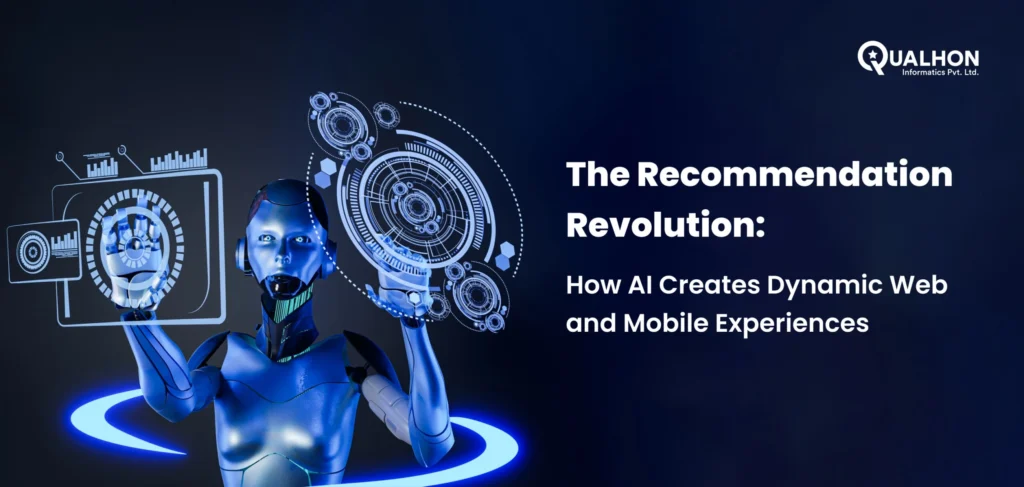From Google and Instagram to Amazon and Spotify, there’s one thing that ties them all together – personalizations. Each platform uses AI recommendations to personalize content feeds and services for every user.
But, why are all businesses focusing on offering personalization in web and mobile apps?
The answer is user experience.
The design and development of a web or mobile app as a static or dynamic design determines the level of personalization it can offer. Static, as the term suggests, does not change the experience according to the user behavior, interaction, or other aspects. It offers limited interactivity and therefore, less engagement. Dynamic web experiences, on the other hand, use databases and real-time updates to offer personalized content, therefore offering high user interactivity and user engagement.
While both designs have pros and cons, the growing need for customized services and products has increased the use of dynamic web and mobile apps. Every aspect of the user’s journey is tailored to their preferences based on reliable data. And in this era of modernization, the artificial intelligence boom has further enhanced dynamic mobile and web apps.
AI recommendations have become more precise and effective for businesses to upsell and cross-sell. AI technology can filter vast amounts of data, identify patterns, predict needs and tailor recommendations to enhance user experience. So, when it comes to personalization and user satisfaction, AI in app development is what you need.
How AI Recommendations Work?
AI recommendations are more than just a trend. It’s a prerequisite in UI/UX design to achieve intuitive designs based on accurate data. AI in web app development is key to delivering dynamic web experiences for users.
Most AI recommendation systems follow the simple principles of data collection, analysis and prediction. But, the complexity of the same will differ based on business requirements. Let’s understand a few basic principles that drive AI recommendation systems.
Data Collection and Analysis
AI recommendation systems leverage machine learning, NLP and big data to collect and filter data. These inputs may include:
User Behavior: clicks, likes, ratings, reviews, purchases.
Contextual Information: user demographic, time, location, gender, device
Service/Product Attributes: popularity, category, features
Engagement Metrics: conversions, time spent, comments, shares.
Once the data is collected, it is analyzed to identify patterns and create different user profiles. It’s an important step because AI recommendation systems function accurately only if there are well-constructed user profiles in the database.
AI Recommendation Filtering Techniques
The accuracy of the recommendation system will depend on the recommendation filtering technique employed in the algorithm. There are three major recommendation filtering techniques.
- Content filtering
- Collaborative filtering
- Hybrid filtering
Content Filtering Technique
This system identifies similarities in the content/item specifications and features. It offers recommendations that align with the user’s previous interaction, for example, similar genres, similar product categories, etc.
Collaborative Filtering Technique
This algorithm triggers recommendations by collaborating the data of user profiles with similar behavior to predict a future interaction or selection with a high probability of success. For example, suggesting a product to user 1 based on the purchases of user 2 since they share a similar history.
Hybrid Filtering Technique
As the term suggests, it is a combination of collaborative and content-filtering techniques. It employs user preferences and item specifications to create a more accurate recommendation. E-commerce platforms like Amazon use this filtering system to create a more personalized recommendation.
Evaluation and Optimization
With AI recommendations, scalability is easier as the system constantly tracks user behavior and feedback which is used in the loop to further enhance recommendations. The system uses metrics about the effectiveness of recommendations, real-time updates about changing user preferences, and feedback. It is used to constantly train the algorithm for more accurate recommendations and user satisfaction. It is one of the primary ways how AI in mobile app development is used for dynamic mobile experiences.
Benefits of AI Recommendations
Increased User Engagement
AI recommendations are strategically placed and timed to enhance user engagement. Since these recommendations are data-based, they are highly relevant to the user forcing them to explore and discover products and services. Personalized recommendations also increase session durations, improve engagement, and retain users.
Improved Conversions
AI recommendations ease the process of upselling and cross-selling. It automatically recommends complementary or higher-value items which helps with conversion rate optimization and increases average order value. AI offers enhanced retargeting with recommendations of items users showed interest in but did not convert therefore improving chances of purchase conversion.
Relevant recommendations also help with lead generation by suggesting the right content or resources prompting users to provide contact information and even referrals.
With ML and NLP, AI recommendation systems take in every input of changed preferences, user behavior and feedback for more accurate recommendations. The constant tracking of data is also helpful with A/B testing of algorithms to get the highest conversion rates.
Enhanced User Satisfaction
With relevant recommendations and easier discovery, AI recommendations add convenience and ease of user experience. Personalization and targeted suggestions make the user journey more streamlined which in turn improves user satisfaction. It also translates to better conversions, better referrals and customer loyalty.
Real-World Use Cases Of AI Recommendations
AI recommendation systems are used in every sphere of human civilization. From e-commerce to healthcare, it finds a use case in every niche. Here are some common use cases of AI recommendations:
E-commerce: E-commerce platforms like Amazon and eBay use AI for cross-selling and upselling of products. They analyze past purchases, search history, etc. to recommend products under ‘People also like’, ‘complete the set’ or ‘frequently bought together’ sections.
Streaming Platforms: Streaming platforms like Netflix, Amazon Prime and Spotify use AI to enhance content recommendations based on viewer history, ratings and preferences. Additionally, AI uses each user profile and data to build personalized playlists for podcasts, music, movies or TV shows.
Fashion and Clothing: From Amazon Fashion to Trunk Club, AI algorithms keep track of trends and item specifications to help users discover relevant items or accessories to style clothing or items.
Social Media: Instagram, Facebook and TikTok are experts at creating a For You Page that is tailored for each user. These recommendations are based on user interaction on the platform.
Online Ads: Google, YouTube and Facebook track the entire digital journey of a user to show only relevant ads to them. These suggestions are generally based on your location, recent search, online activity and other digital aspects.
The Future of AI Recommendations
Whether it’s your food app drawing you to order the pizza you had last week, or Netflix enticing you to resume the movie, there’s AI recommendation everywhere. But, the future of AI recommendations easily extends to more than just the entertainment sector.
It is safe to say that AI recommendation systems have a wide scope in the healthcare, finance, learning and even logistics sectors.
Its ability to analyze historical data and identify patterns could improve the functioning of healthcare systems. From identifying and escalating urgent cases to assisting with diagnosis and clinical trials, there’s huge potential.
Similarly, AI recommendations in finance could be useful for credit risk assessments, better market analysis for trading opportunities and portfolio optimization strategies.
Keeping up with personalizations, we can also expect hyper-personalization which will also consider contextual data and data types including images and audio for more user satisfaction.
Conclusion
There’s no brand, business or entrepreneur who can escape the power of AI. With users demanding personalization, AI is the best way to make it happen. It’s not just a way to modernize your business, it is the very thing that improves the prime aspects of business – user satisfaction, engagement, conversions and loyalty.
If you have a growing business that is looking forward to stepping into the new era of AI recommendations, Qualhon experts can help you out. With industry-specific solutions, and listed as top 10 Mobile App Development Company (India) they have the skills and technology to find your AI solution. Contact Qualhon for AI-powered app development and web application development and join the future of personalization.



